What Is a Whiteboard Marker Made of
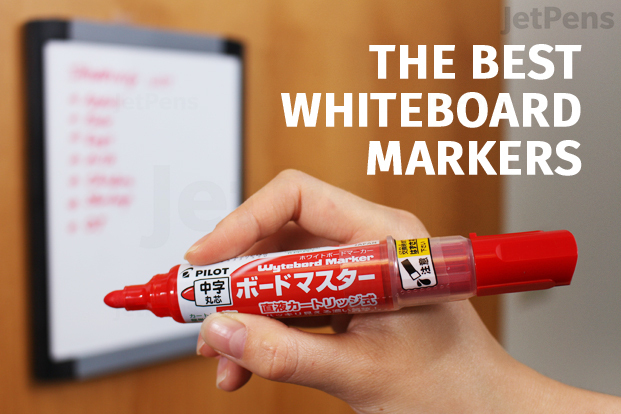
Whiteboard markers are the unsung heroes of conference rooms and classrooms. These understated writing tools let you solve problems and brainstorm ideas freely, without the permanence of pen and paper. The most satisfying ones lay down bold lines that your colleagues can see from across the room, flow as fast as your thought process, and erase with ease. Keep reading to learn how to choose whiteboard markers and which ones work best for specific uses. We'll cover both standard dry erase whiteboard markers and wet erase board markers.
Considerations
Erasability
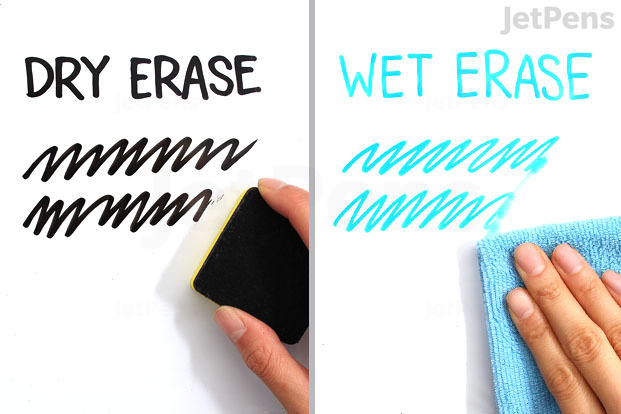
Dry erase markers are solvent-based and will wipe off without water, whereas wet erase markers contain a semi-permanent paste and require water for removal.
When you use a whiteboard marker, the ink should last long enough to serve its purpose but also easily erase. For brainstorming and scratch notes, we recommend dry erase markers. These markers are solvent-based and will wipe off without water. For signage and long-term projects, use wet erase markers. A wet erase marker contains a semi-permanent paste that requires water for removal. Rubbing alcohol and household cleaners will remove more stubborn wet erase marks that are left on for a long time.
Tip Material
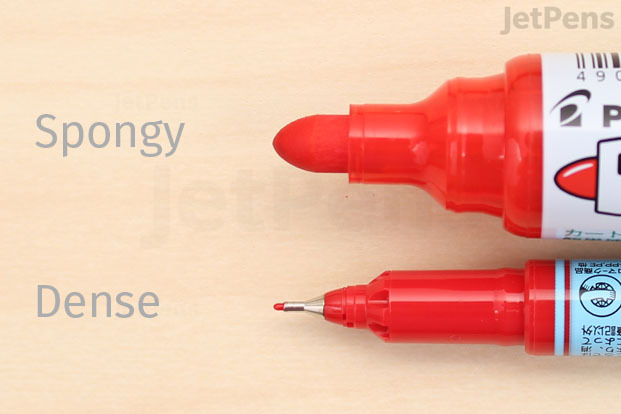
There are two types of felt-tip markers. One is made of a spongy loosely packed fiber and the other is made of a hard, densely packed fiber.
Tip material affects feedback, tip longevity, and line precision. Whiteboard markers typically have "felt" tips made from materials such as nylon or polyester. Two types of felt-tip markers exist. One is a densely packed fiber housed in a plastic or metal funnel. These tips hold their shape longer and create consistent lines. However, users may experience more feedback with them because they feel harder and produce more friction on a whiteboard surface. The other kind of felt tip is made of a spongy, loosely packed fiber, which lends the tip flexibility. While easier to write with, these fray over time.
Tip Shape & Size
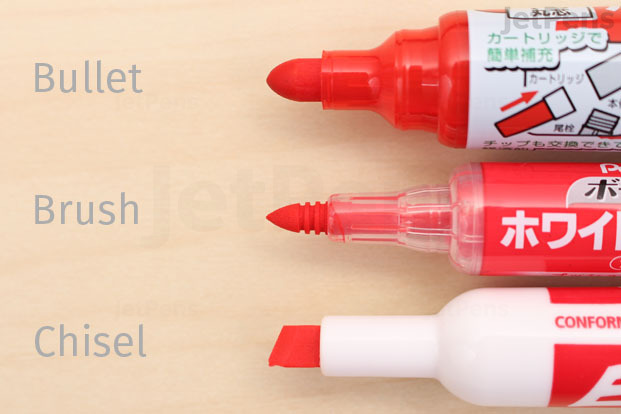
Chisel or brush tips yield more varied strokes while rounded bullet tips produce less varied strokes.
Chisel or brush tips yield more varied strokes while rounded bullet tips produce less varied strokes. The latter, however, are easier to control. Tip size is also important. Thin tips allow for more detail but those who write with them may experience more feedback. In contrast, broad tips create less detail but are smoother to write with.
Marker Body & Components
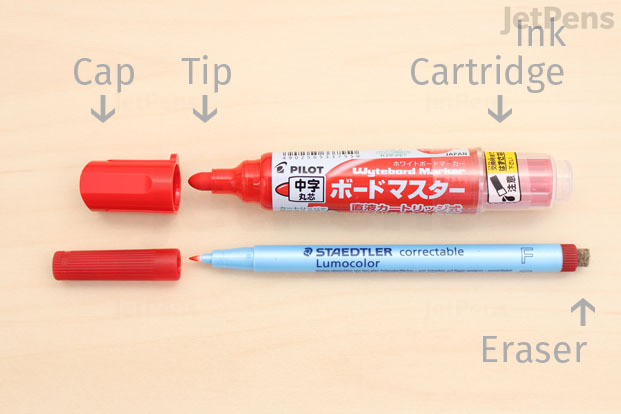
A whiteboard marker's composition can affect its performance.
A whiteboard marker's composition can affect its performance. Polypropylene plastic (PP) provides the most durability and impact resistance. Caps and pen bodies made of PP won't break easily and tend to stay tightly sealed to ensure the longevity of a whiteboard marker. The internal design of a board marker can also impact how long it lasts. For example, the Pilot Board Master Whiteboard Marker is a refillable marker with special ink delivery technology that makes it consistent. Consider the durability or replaceability of the tip if you select refillable whiteboard markers, which need to last longer.
Drying Out
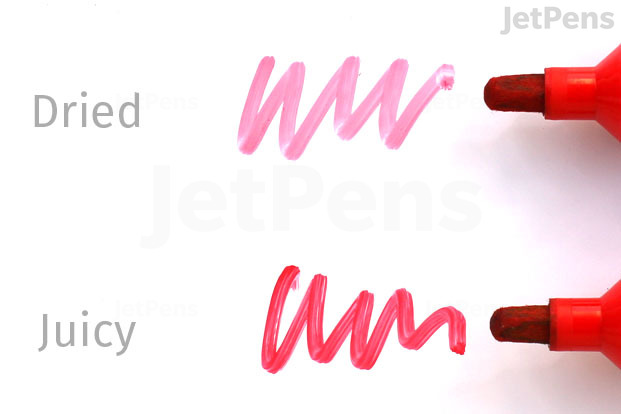
How you store your markers can affect how juicy they stay.
The woe of many a whiteboard marker user is that whiteboard markers dry out quickly. To maximize their longevity, store whiteboard markers horizontally. Long-term vertical positioning with the tip pointing upwards causes the pigment to precipitate out of the solution, leaving the tip with reduced color. If this happens to you, don't panic; there are ways to revive dead markers. One way is to temporarily store the marker with the tip facing downwards so that the ink saturates the tip. You can also use pliers to completely remove the tip and turn it to the "juicier" side.
Odor
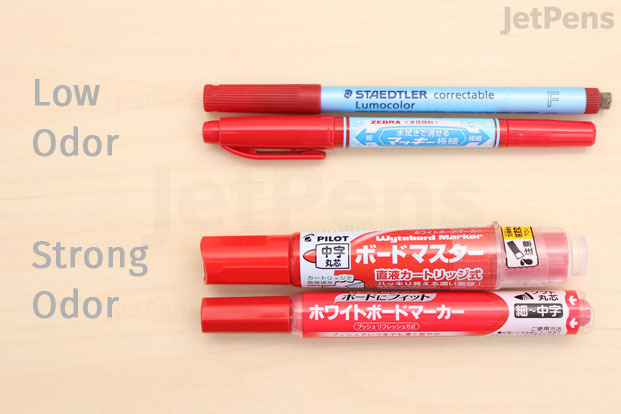
Most whiteboard markers are alcohol-based, so they will emit some kind of odor.
For those sensitive to strong odors or in closed areas with lots of people, use low-odor markers. Some of the most low-odor markers include the Zebra Mackee Double-Sided Wet Erase Markers and the Staedtler Lumocolor. Most whiteboard markers are alcohol-based, so they will emit some kind of odor. We suggest keeping your working area well-ventilated.
Pigmentation
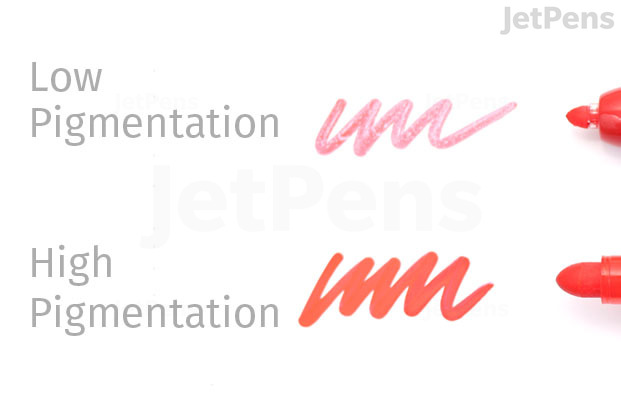
Another consideration when selecting whiteboard markers is pigmentation.
Another consideration when selecting whiteboard markers is pigmentation. If you often give presentations or teach classes, you know how important it is for people to be able to see what you write on the board. On the other hand, if intense colors are hard on your eyes, you may prefer lighter shades.
Writing Surface
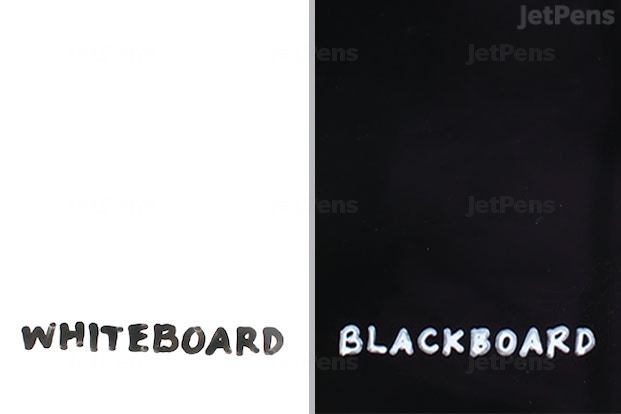
Differences in surface texture affect staining and erasability.
Differences in surface texture affect staining and erasability. Dry erase markers work best on smooth, nonporous surfaces. Porcelain-on-steel whiteboards are the best to use because they are smooth and easy to clean. Cheaper alternatives include powder-coated steel, painted steel or aluminum, and glass. Wet erase markers work best on laminated surfaces, though they will write on and erase from any smooth, nonporous surface.
Best Overall
A superb whiteboard marker sports a fray-resistant tip that writes with precision, produces juicy and bold lines, and erases in one swipe.
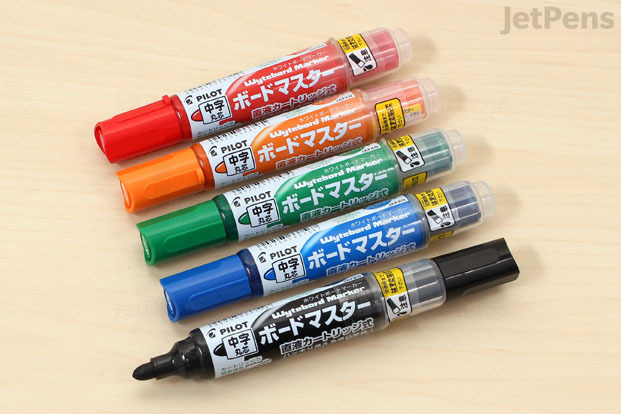
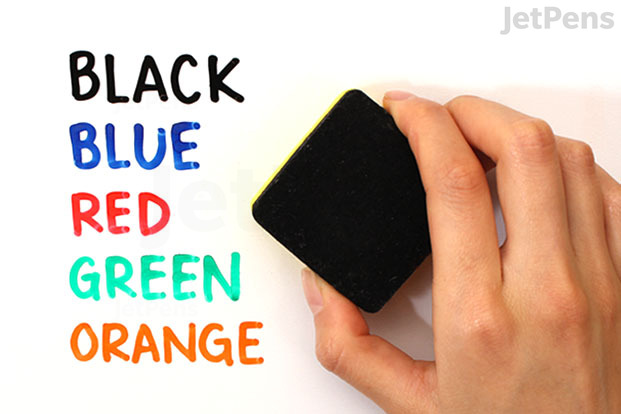
Pilot Board Master Whiteboard Marker Sample
The Pilot Board Master Whiteboard Marker is a top-of-the-line whiteboard marker. It's visible from across the room because the marker is broad and the ink is highly pigmented. The thick spongy tip creates consistently vibrant lines and is easy to control. There's a lot of science behind what makes this pen so consistent and easy to control. The Board Master Whiteboard Marker uses a twin pipe feeder (TPF) system with two pipes that connect the ink supply to a cotton reservoir at the tip. One pipe allows ink to flow out while the other allows air to flow in, which equalizes the air pressure inside and outside the marker so that ink flow remains constant. This mechanism guarantees consistently sharp, vibrant lines until the cartridge runs out of ink.
To replace the cartridge, keep the pen tip capped and pointing upwards. Then, unscrew the clear bottom section and replace the old cartridge. Because the tips are softer and spongier, they do tend to fray. It is possible, however, to purchase replaceable tips for your markers. The refillable cartridges and pen tips available for this product line are both economical for the consumer and sustainable for the earth. The one small drawback of this marker is that it gives off a strong smell of alcohol, so be sure to keep your working area ventilated.
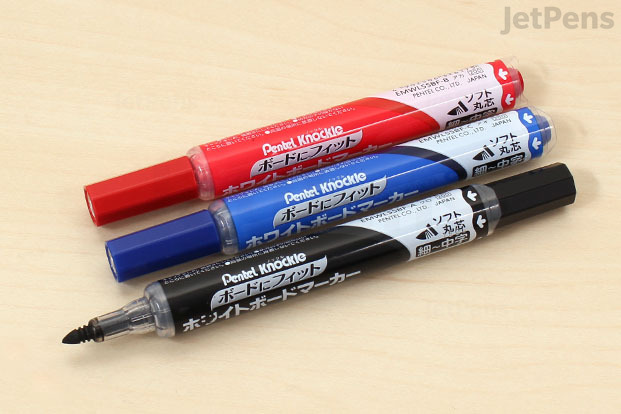
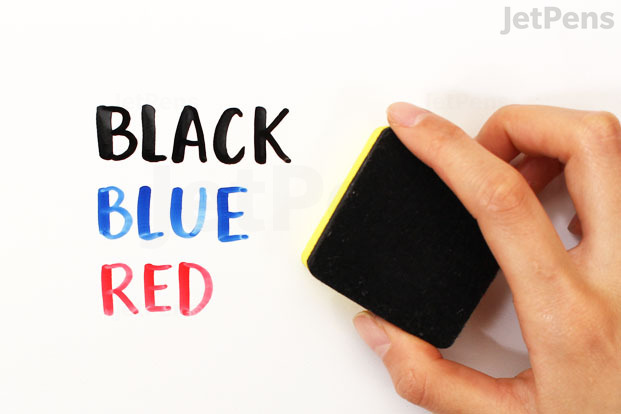
Pentel Knock Whiteboard Marker Sample
If you enjoy creating fancy lettering or calligraphy, you'll love playing around with the Pentel Knockle. As a tip material, nylon is flexible and durable but tends to clog easily. Pentel pen engineers tackled this issue by including rib-like slits on the side of the Knockle's tip so that ink can travel to the tip easily. Because of its flexibility and ink saturation, the Knockle tip allows users to experiment with a variety of different strokes while the ink remains bold and pigmented. To activate the tip, post the cap, press down, and wait for the ink to saturate the pen. Do keep in mind that while the nylon tip is more durable than polyester, it remains vulnerable to splaying and does not have replacements available.
It's Personal - Markers for Notes
Not all whiteboard markers live in a lecture hall or conference room People also use whiteboard markers for filling out personal calendars, leaving roommate messages, and writing to-do lists. For personal purposes, we recommend pens with fine tips for fitting words onto small whiteboards and convenient designs for easy, foolproof storage.
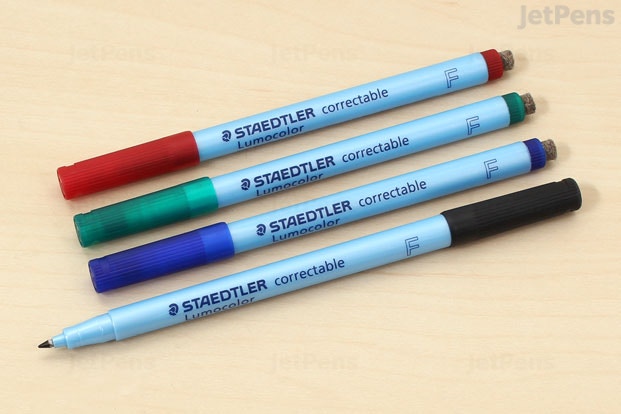
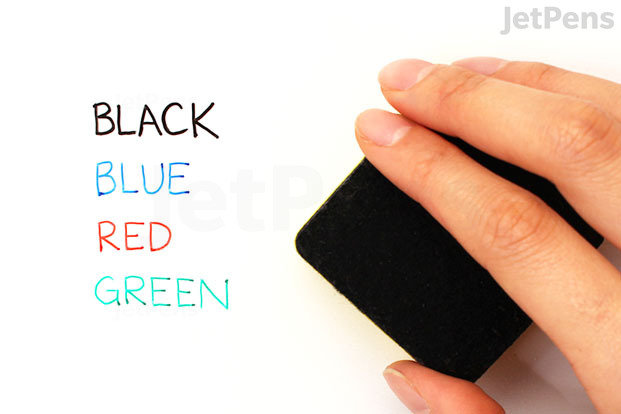
Staedtler Lumocolor Correctable Dry Erase Pen Sample
The low-odor Lumocolor markers come in pearlescent blue bodies with mini felt erasers. The solid, densely packed fiber tip lasts a long time and produces consistent, thin 0.6 mm lines. The PP material in the barrel and cap offers impact resistance, which means the pen won't crack or chip easily and protects the ink inside from drying. Moreover, the vibrant and lightfast ink works well for color-coding personal notes, tasks, and ideas. While the Lumocolor marker is technically a dry erase marker, cleaning its marks requires more than just the attached felt eraser. Use water or rubbing alcohol to thoroughly get rid of stray stains.
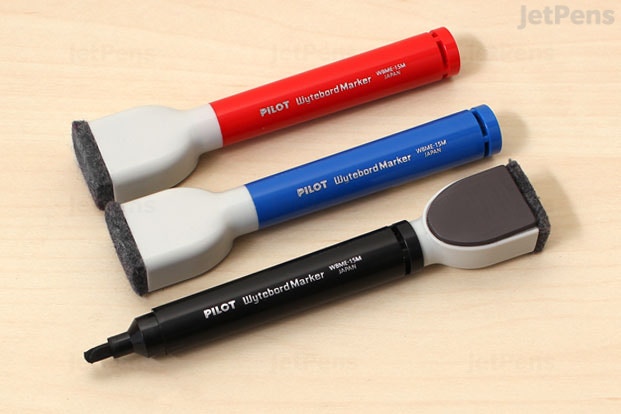
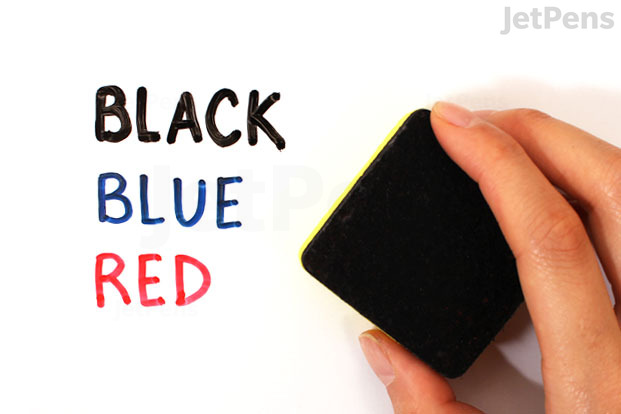
Pilot Wytebord Refillable Whiteboard Marker Sample
The Pilot Wytebord Marker is a refillable marker, so you can purchase refill ink to keep the marker boldly saturated while doing some good for the earth. To refill it, open the non-tip end of the pen with a coin, insert the included spout into the cotton center of the pen, and fill the pen with ink. Additionally, these markers come with felt erasers attached to the cap. The eraser efficiently cleans ink off of small surfaces, such as whiteboard calendars or mini whiteboards. The erasers especially help those who tend to erase with their fingers. The caps also have magnetic backings, which make them handy for sticking onto the fridge or the magnetic part of a cubicle so that you won't lose them.
While the refillable method is easy and convenient, it's worth considering that the spongy tip is vulnerable to fraying over time. Also note that the ink formula has a distinct alcohol smell, especially if you have a sensitive nose.
Chalking It Out
These chalk markers offer the powdery finish of chalk in addition to easy control and clean-up. They show up best on plastic blackboards. We don't recommend using them on conventional chalkboards, though, since these are porous and will absorb the ink.
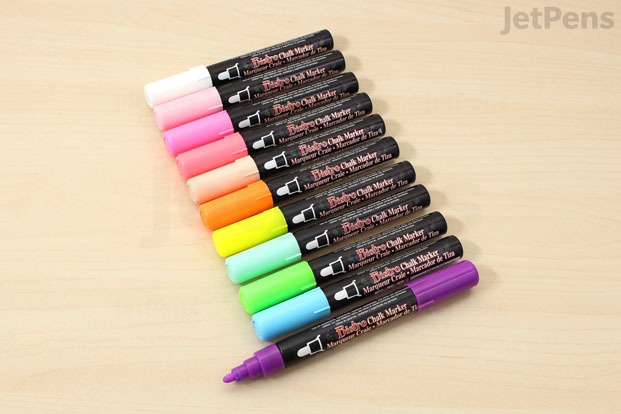
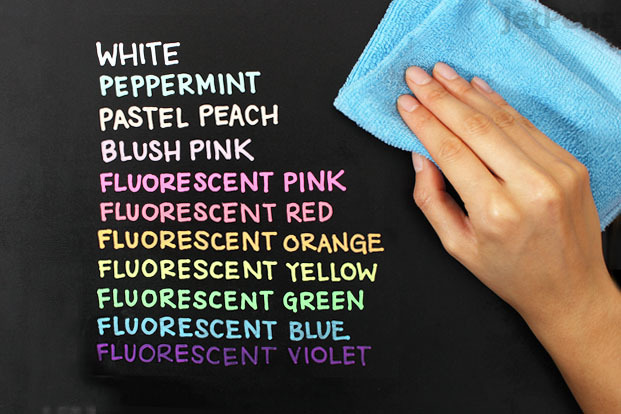
Marvy Uchida Bistro Chalk Marker Sample
The fluorescent Marvy Uchida Bistro Chalk Marker appears vibrantly on dark, nonporous surfaces, such as plastic blackboards or tinted windows. Its hard bullet tip offers smooth control and creates round and narrow lines. The ink is also very easy to work with - it emits a low odor, is reliably opaque, and removes easily with a damp cloth. In order to ensure the longevity of this pen, store it horizontally, keep the cap tightly sealed, and avoid leaving it in extreme temperatures. Activate this marker like you would any paint marker: push down the tip, shake it with the cap closed, and wait for the tip to saturate. One thing to consider is that it does have a slight glue-like odor.
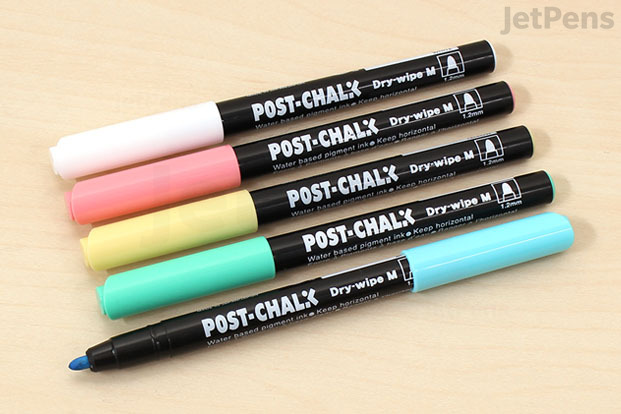
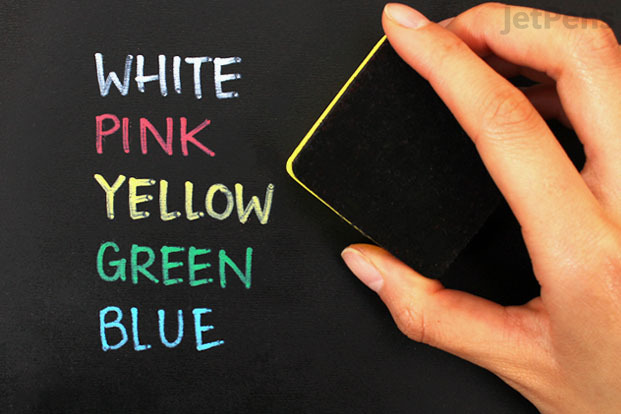
Kuretake Post Chalk Markers Sample
The Kuretake Post Chalk Markers first appear wet and transparent but then gradually transform into an opaque, classic chalk finish, popping vibrantly on surfaces such as blackboards and glass. Their 1.2 mm bullet tips are sturdy enough for precise control. The ink rarely budges on nonporous surfaces and works well for lettering and illustrations that need to last over time. The Kuretake Post Chalk Markers require more effort to remove than most dry eraser markers. To tidily remove the chalk, wipe hard with a dry cloth. Use a dampened cloth for cleaning remaining streaks or marks.
It's a Sign - Markers for Signage
Attract customers to your business or jazz up events by creating signs with these vibrant pens. We recommend wet erase markers for signs because they tend to last longer and will not budge unless you expose them to water or rubbing alcohol. These, like the chalk markers, look best on blackboards. Both the recommendations below can be activated simply by pressing down the tip and shaking the pen with the cap on so that the tip saturates with ink. Keep in mind that both also have a mild glue odor, so work in a well-ventilated area.
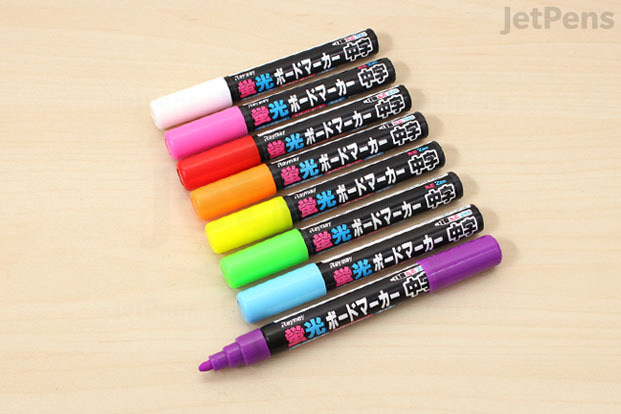
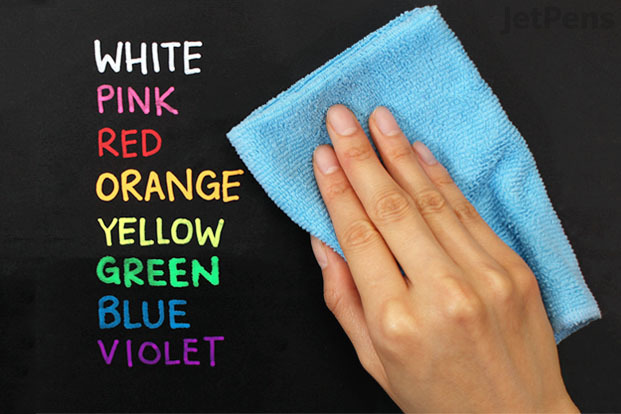
Raymay Fluorescent Board Marker Sample
The RayMay Fluorescent Marker combines the vivacity of neon highlighters with the opaqueness of paint markers. This results in an electrifying finish that looks great on signs. The thick body is easy to hold, which makes the marker more ergonomic and easy to control for board lettering and decorative signage. The ink is water-based and easy to remove with a damp towel. Keep in mind that the bullet tip is very thick, which limits the variation of your strokes.
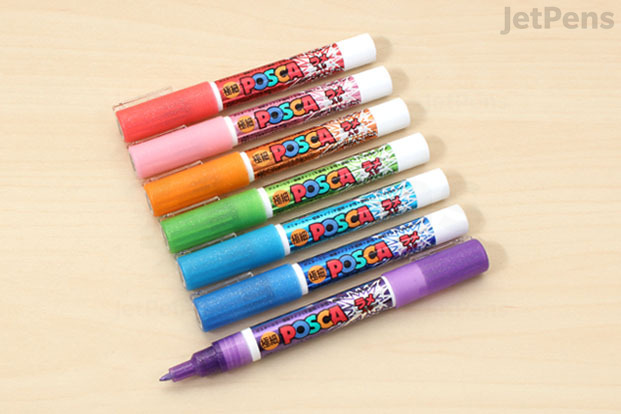
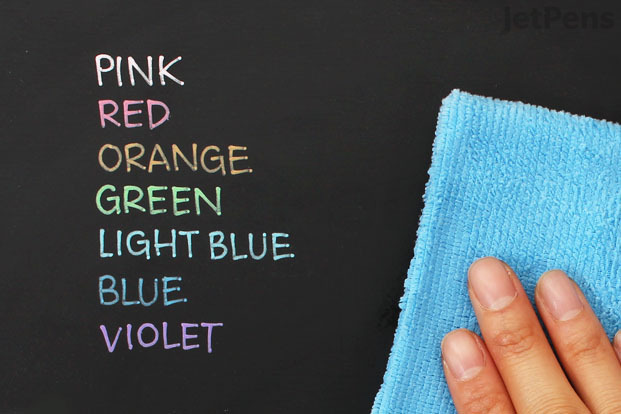
Uni Posca Glitter Marker Sample
The Uni Posca Glitter Paint Markers add glam to luxurious events like weddings and launch parties. They offer the subtle shimmer of sparkly nail polish when they are completely dry and look great on both black paper and blackboards. Their tapered tips are sturdy enough for newbies to control yet are flexible enough to create different strokes. To remove these markers from nonporous surfaces, you can use either a scraper or rubbing alcohol.
Related Posts
What Is a Whiteboard Marker Made of
Source: https://www.jetpens.com/blog/the-best-whiteboard-markers/pt/919

0 Response to "What Is a Whiteboard Marker Made of"
Post a Comment